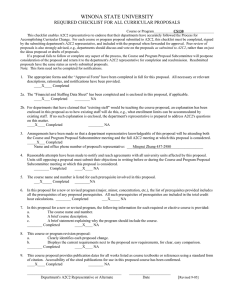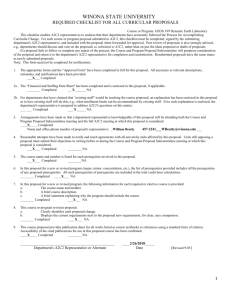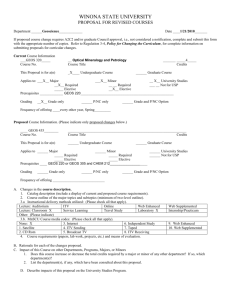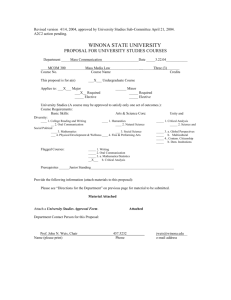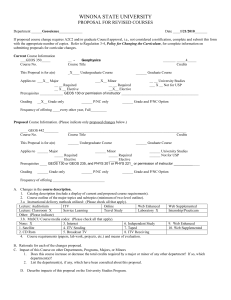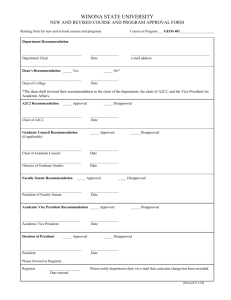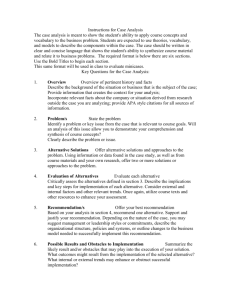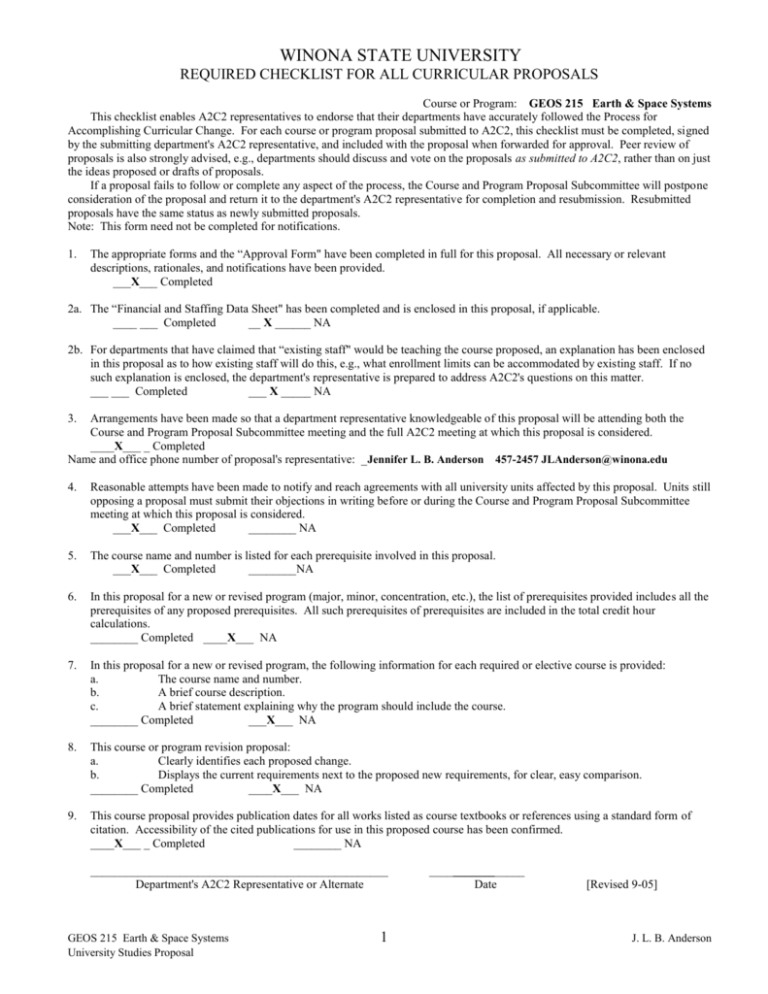
WINONA STATE UNIVERSITY
REQUIRED CHECKLIST FOR ALL CURRICULAR PROPOSALS
Course or Program: GEOS 215 Earth & Space Systems
This checklist enables A2C2 representatives to endorse that their departments have accurately followed the Process for
Accomplishing Curricular Change. For each course or program proposal submitted to A2C2, this checklist must be completed, signed
by the submitting department's A2C2 representative, and included with the proposal when forwarded for approval. Peer review of
proposals is also strongly advised, e.g., departments should discuss and vote on the proposals as submitted to A2C2, rather than on just
the ideas proposed or drafts of proposals.
If a proposal fails to follow or complete any aspect of the process, the Course and Program Proposal Subcommittee will postpone
consideration of the proposal and return it to the department's A2C2 representative for completion and resubmission. Resubmitted
proposals have the same status as newly submitted proposals.
Note: This form need not be completed for notifications.
1.
The appropriate forms and the “Approval Form" have been completed in full for this proposal. All necessary or relevant
descriptions, rationales, and notifications have been provided.
___X___ Completed
2a. The “Financial and Staffing Data Sheet" has been completed and is enclosed in this proposal, if applicable.
____ ___ Completed
__ X ______ NA
2b. For departments that have claimed that “existing staff" would be teaching the course proposed, an explanation has been enclosed
in this proposal as to how existing staff will do this, e.g., what enrollment limits can be accommodated by existing staff. If no
such explanation is enclosed, the department's representative is prepared to address A2C2's questions on this matter.
___ ___ Completed
___ X _____ NA
3.
Arrangements have been made so that a department representative knowledgeable of this proposal will be attending both the
Course and Program Proposal Subcommittee meeting and the full A2C2 meeting at which this proposal is considered.
____X___ _ Completed
Name and office phone number of proposal's representative: _ Jennifer L. B. Anderson 457-2457 JLAnderson@winona.edu
4.
Reasonable attempts have been made to notify and reach agreements with all university units affected by this proposal. Units still
opposing a proposal must submit their objections in writing before or during the Course and Program Proposal Subcommittee
meeting at which this proposal is considered.
___X___ Completed
________ NA
5.
The course name and number is listed for each prerequisite involved in this proposal.
___X___ Completed
________NA
6.
In this proposal for a new or revised program (major, minor, concentration, etc.), the list of prerequisites provided includes all the
prerequisites of any proposed prerequisites. All such prerequisites of prerequisites are included in the total credit hour
calculations.
________ Completed ____X___ NA
7.
In this proposal for a new or revised program, the following information for each required or elective course is provided:
a.
The course name and number.
b.
A brief course description.
c.
A brief statement explaining why the program should include the course.
________ Completed
___X___ NA
8.
This course or program revision proposal:
a.
Clearly identifies each proposed change.
b.
Displays the current requirements next to the proposed new requirements, for clear, easy comparison.
________ Completed
____X___ NA
9.
This course proposal provides publication dates for all works listed as course textbooks or references using a standard form of
citation. Accessibility of the cited publications for use in this proposed course has been confirmed.
____X___ _ Completed
________ NA
__________________________________________________
Department's A2C2 Representative or Alternate
GEOS 215 Earth & Space Systems
University Studies Proposal
1
________________
Date
[Revised 9-05]
J. L. B. Anderson
WINONA STATE UNIVERSITY
PROPOSAL FOR UNIVERSITY STUDIES COURSES
Department GEOSCIENCE
Date March 27, 2010
GEOS 215
Course No.
Earth & Space Systems
Course Name
This proposal is for a(n)
___X___ Undergraduate Course
Applies to: ___XX___ Major
_XX_ Required
_____ Elective
4
Credits
______ Minor
_____ Required
_____ Elective
University Studies (A course may be approved to satisfy only one set of outcomes.):
Course Requirements:
Basic Skills:
Arts & Science Core:
_____ 1. College Reading and Writing
_____ 2. Oral Communication
_____ 3. Mathematics
_____ 4. Physical Development & Wellness
Flagged Courses:
_____ 1. Humanities
__XX__ 2. Natural Science
_____ 3. Social Science
_____ 4. Fine & Performing Arts
Unity and Diversity:
_____ 1. Critical Analysis
_____ 2. Science and Social Policy
_____ 3. a. Global Perspectives
_____ b. Multicultural Perspectives
_____ 4. a. Contemporary Citizenship
_____ b. Democratic Institutions
_____ 1. Writing
_____ 2. Oral Communication
_____ 3. a. Mathematics/Statistics
_____ b. Critical Analysis
Prerequisites Permission of the Instructor
Provide the following information (attach materials to this proposal):
1.
2.
3.
4.
5.
6.
7.
Course proposals must address all specified outcomes.
The course proposal must include documentation of Course Requirements and learning activities designed to meet the
course outcomes specifics for the area.
The course proposal must include a course description (e.g., a syllabus or course outline for distribution to students) that
clearly identifies (to the student) the course as a University Studies Course.
The course description (e.g., a syllabus or course outline for distribution to students) should also include information
directed to the student that clearly identifies course activities and assignments that address the course outcomes.
Sequences of courses may be submitted to satisfy area requirements. In this case the requested material or documentation
in items 1-4 must be submitted for all of the courses in the sequence.
The USS may request other material (e.g., textbooks) for review in evaluation course proposal.
The USS may request additional information for re-approval.
Attach a University Studies Approval Form.
Department Contact Person for this Proposal:
______ Jennifer L. B. Anderson _____
___
Name (please print)
____457-2457___
_______ JLAnderson@winona.edu
Phone
e-mail address
[Revised 9-05]
GEOS 215 Earth & Space Systems
University Studies Proposal
2
J. L. B. Anderson
Course Catalog Description
215 – Earth & Space Systems – 4 S.H.
An introduction to the Earth System and its place in our Universe designed specifically for 5-12 science education majors. Inquirybased exploration of the processes and relations between the lithosphere, hydrosphere, atmosphere, and biosphere, including
internal and external energy inputs. Comparison of Earth to other planets in our solar system. Investigation of the various ways
that humans interact with these Earth systems. Focus on development of pre-service student pedagogical content knowledge and
connections to state and national science education standards as relates to teaching Earth and space science in grades 5-12. Field
trips required. Lecture and laboratory combined. Prerequisites: Permission of instructor. Offered yearly.
Course Outline
1. Introduction to Earth & Space Systems
a. Lithosphere
b. Hydrosphere
c. Atmosphere
d. Biosphere
e. External Energy
i. the Sun
f. Internal Energy
i. Gravitational Contraction
ii. Radioactive Decay
2. Our Solar System I
a. Classification & Scales
b. General Overview
c. Our Star
d. Planetary Motions
e. Phases of the Moon & Eclipses
3. The Structure of the Earth
a. Planetary Formation
b. Planetary Differentiation
c. Chemical Layers
d. Physical Layers
4. Earth Materials & Processes
a. Elements, Chemistry, and Minerals
b. Rock Classification
c. Volcanism & Igneous Rocks
d. Weathering & Sedimentary Rocks
e. Mountain Building & Metamorphic Rocks
f. Earthquakes
g. Impact Cratering
5. Plate Tectonics
a. Observations and Evidence
i. Continental Shapes
ii. Fossils
iii. Mountain Ranges
iv. Rock Types
v. Glaciers and Deserts
vi. Magnetism and Sea Floor Spreading
b. The Unifying Theory of Geology
c. Topography/Bathymetry
d. Earthquake Locations
e. Volcano Locations
f. Hot Spot Volcanism
GEOS 215 Earth & Space Systems
University Studies Proposal
6. The Solar System II
a. Earth & Her Sister Planets
i. How/Why are they Similar?
ii. How/Why are they Different?
b. Solar System Formation
c. Exo-Solar Systems
7. History of the Earth
a. Geologic Time
b. Life & Mass Extinctions
8. The Universe
a. History
b. Future
9. The Role of Water
a. Water Reservoirs
b. The Water Cycle
10. Atmospheres
a. Composition and Structure
b. Energy and Heat
c. Earth’s Orbit & Seasons
d. Atmospheric Convection
e. Weather & Storms
11. Climate
a. Global Climate Patterns
b. Climate Change in Earth’s History
c. C, N, O Cycles
d. Human Influences on Climate
12. Human Interactions
a. Mineral and Energy Resources
b. Land and Water Use Practices
c. Natural Hazard Mitigation
3
J. L. B. Anderson
Course requirements and means of evaluation
We will meet for three hours of lecture and three hours of lab each week, but the lecture and lab time will be integrated so that we
meet in blocks of time, for example in three two-hour class periods throughout the week. This will allow for more hands-on, inquirybased exploration of the course content as well as the opportunity for pre-service teachers to learn in an environment that will be more
similar to their future 5-12 grade classroom. Students will be evaluated via their in-class work, assigned homework, lab activities and
reports, and standard exams.
Assessment of Outcomes
Students will be assessed on the following:
Two to Three Mid-term Exams (~20% each)
Final Exam (~20%)
Homework, Lab, and Field-Based Assignments (~30%)
In-Class Participation & Discussion
(~10%)
Grading (Students must take the course for a letter grade):
A = 90 – 100
B = 80 – 89
C = 70 – 79
D = 60 – 69
F = < 60
Course materials (textbook(s), bibliography, additional references)
Grotzinger, J., Jordan, T.H., Press, F., and Siever, R. (2007) Understanding Earth, 5th ed. WH Freeman.
Kump, L.R., Kasting, J.F., and Crane, R.G. (2004) The Earth System, 2nd ed. Pearson Prentice Hall: Upper Saddle River.
Mackenzie, F.T. (1998) Our Changing Planet: And Introduction to Earth System Science and Global Environmental Change, 2 nd
ed. Pearson Prentice Hall: Upper Saddle River.
McConnell, D.A., Steer, D., Owens, K., and Knight, C. (2010) The Good Earth: Introduction to Earth Science, 2 nd ed. McGraw
Hill: Dubuque.
Reynolds, S., Johnson, J., Kelly, M., Morin P., and Carter, C. (2010) Exploring Geology, 2nd ed. McGraw-Hill: Dubuque.
Skinner, B.J., Porter, S.C. and Botkin, D.B. (1999) The Blue Planet: An Introduction to Earth System Science, 2 nd ed. Wiley: New
York.
Tarbuck, E.J., Lutgens, F.K., and Tasa, D. (2009) Earth Science, 12th ed. Pearson Prentice Hall: Upper Saddle River.
Zaprowski, B. (2005) Earth & Beyond: An Introduction to Earth-Space Science Laboratory Manual, 3rd ed. McGraw-Hill:
Dubuque.
***Readings from popular science magazines and peer-reviewed scientific literature will also be assigned periodically
Major Focus and Course Objectives
Course objectives will be achieved via in-class activities and discussion, lecture, homework, lab activities, and field work.
Examine the interrelationships between the Earth’s major systems (lithosphere, hydrosphere, atmosphere, and biosphere),
and its energy sources (the Sun, radioactivity, and gravitational contraction).
Examine the role that life has played and continues to play in these systems, particularly human interactions.
Investigate the elements, minerals, and rocks that make up the Earth, the processes that form them, and where they are
found within the internal structure of the Earth.
Investigate the unifying theory of geology, plate tectonics, including the evidence for this theory, its role throughout
Earth’s history, its implications for natural disasters, and how tectonics is expressed throughout the solar system.
Investigate the Earth’s atmosphere, weather, climate, and the role of water and oceans.
Place the Earth within the context of our solar system, focusing on why the Earth is similar or different to its sister planets
and what this tells us about the Earth.
GEOS 215 Earth & Space Systems
University Studies Proposal
4
J. L. B. Anderson
University Studies Outcomes
The following U.S. statement to students exactly as it will be included on syllabus:
This course qualifies as a University Studies course satisfying the outcomes of the Natural Science Category. If you
successfully complete the course requirements, you will earn 4 credits toward completion of the Natural Science with
Laboratory category.
The purpose of the Natural Science requirement in the University Studies program is to provide students with the tools to
understand and be able to apply the methods by which scientific inquiry increases our understanding of the natural world.
GEOS 215 is designed specifically with 5-12 science teachers in mind and so the majority of the class will be hands-on,
inquiry-based group activities and exercises which model good practice for how you, as future science teachers, could interact
with your future 5-12 students. This is a particularly powerful means to help you address the following outcomes which will be
integrated throughout the course content.
These courses must include requirements and learning activities that promote students' abilities to...
a.
understand how scientists approach and solve problems in the natural sciences;
Working in groups, students will explore and experience how scientists approach and solve problems in geology,
astronomy, meteorology, and environmental science. The history of astronomy and geology are explored so that
students gain an appreciation for how these fields and their fundamental theories developed over time. They will
utilize standard methods employed in interpreting and solving geologic and astronomical problems. Through inquiry,
students are encouraged to view the process of science as a living, growing, and changing body of knowledge and as a
way to approach the natural world and make educated decisions about Earth and space-science related issues such as
climate change.
b.
apply those methods to solve problems that arise in the natural sciences;
Students will apply basic geologic and astronomical methods to solving problems. The inquiry-based laboratory
activities challenge students to step outside of their comfort zone and work toward a solution of a problem. Students
will integrate many different concepts from astronomy and geosciences in order to address realistic (though
simplified) problems.
c.
use inductive reasoning, mathematics, or statistics to solve problems in natural science;
As part of the inquiry-based activities, students will use inductive reasoning and mathematics as they solve problems.
For example, mathematics and data analysis will be used when monitoring and analyzing meteorological data
throughout the semester as well as in other activities. Inductive reasoning will be utilized as students complete
inquiry-based laboratory activities wherein they explore plate tectonics, Earth materials, and the classification of our
Solar System.
d.
engage in independent and collaborative learning;
The majority of activities will be completed in groups of 2-4 students in part to model the best practice for teaching
science to 5-12 students and to encourage collaboration and team-work between students which mimics the true
process of science. Independent learning is ensured by homework assignments and laboratory exams.
e.
identify, find, and use the tools of information science as it relates to natural science;
Throughout the semester, students will work with real geologic and astronomical data as part of their laboratory
activities. Google Earth, Google Moon, Stellarium, and meteorological websites will be used within assignments and
laboratory exercises along with Microsoft Excel for data analysis.
f.
critically evaluate both source and content of scientific information; and
As part of course activities and assignments, students will be asked to critically evaluate scientific information by
interpreting various datasets and the various hypotheses offered as explanations of the observations. In addition,
students will read and evaluate how science is presented to the general public through popular science magazines and
television shows.
g.
recognize and correct scientific misconceptions.
All students, college-level and 5-12, carry scientific misconceptions with them. Students will be challenged to
identify their misconceptions and then reason their way to a more correct understanding through inquiry-based
activities and new information as presented.
GEOS 215 Earth & Space Systems
University Studies Proposal
5
J. L. B. Anderson
WINONA STATE UNIVERSITY
UNIVERSITY STUDIES APPROVAL FORM
Routing form for University Studies Course approval.
Department Recommendation
Course____GEOS 215 Earth & Space Systems_____
_____ Approved
_________________________________
Department Chair
________________
Date
Dean’s Recommendation _____ Approved
_________________________________
Dean of College
_____ Disapproved
____________________________________________
e-mail address
_____ Disapproved*
________________
Date
*In the case of a dean’s recommendation to disapprove a proposal, a written rationale for the recommendation to disapprove shall
be provided to the University Studies Subcommittee.
USS Recommendation
_____ Approved
_________________________________
University Studies Director
A2C2 Recommendation
_____ Disapproved
________________
Date
_____ Approved
_________________________________
Chair of A2C2
Faculty Senate Recommendation
_____ Disapproved
________________
Date
_____ Approved
_________________________________
President of Faculty Senate
_____ Disapproved
________________
Date
Academic Vice President Recommendation _____ Approved
_________________________________
Academic Vice President
Decision of President
_____ Approved
_________________________________
President
_____ No recommendation
_____ Disapproved
________________
Date
_____ Disapproved
________________
Date
Please forward to Registrar.
Registrar
_________________
Date entered
Please notify department chair via e-mail that curricular change has been recorded.
[Revised 9-05]
GEOS 215 Earth & Space Systems
University Studies Proposal
6
J. L. B. Anderson

